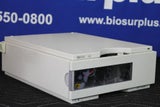- Store
- >
- Refurbished & Used
- >
- HPLCs
- >
- Agilent ALS Therm G1330A thermostat unit
Agilent ALS Therm G1330A thermostat unit
SKU:
$3,800.00
$2,650.00
$2,650.00
Unavailable
per item
Agilent ALS Therm G1330A thermostat unit
The Agilent 1100 Series autosampler is designed for use with other modules of the Agilent 1100 Series LC system, with the HP 1050 Series, or with other LC systems if adequate remote control inputs and outputs are available. The autosampler is controlled from the Agilent 1100 Series control module or from the Agilent ChemStation for LC systems.
Sold out
The Agilent 1100 Series autosampler is designed for use with other modules of the Agilent 1100 Series LC system, with the HP 1050 Series, or with other LC systems if adequate remote control inputs and outputs are available. The autosampler is controlled from the Agilent 1100 Series control module or from the Agilent ChemStation for LC systems.
The specially-designed thermostattable sample trays holds either 100 × 1.8 ml vials or two wellplates and 10 × 1.8 ml vials.
The ALS thermostat contains Peltier-controlled heat exchangers. A fan draws air from the area above the sample vial tray of the autosampler and is then blown through the fins of the cooling/heating module. There it is cooled or heated according to the temperature setting. The thermostatted air enters the autosampler through a recess underneath the specially-designed sample tray. The air is then distributed evenly through the sample tray ensuring effective temperature control, regardless of how many vials are in the tray.
In cooling mode condensation is generated on the cooled side of the Peltier elements. This condensed water is safely guided into the leak system.
The thermostatted autosampler is equipped with a cooling/heating module which uses Peltier elements for efficient air cooling. When turned on the front side of the Peltier elements is heated/cooled according to the temperature setting. A fan draws air from the sample tray area and blows it through the channels of the heating/cooling module. The fan speed is determined according to the environmental conditions (e.g., ambient temperature, humidity). In the heating/cooling module the air reaches the temperature of the Peltier elements and this thermostatted air is blown underneath the special sample tray where it is evenly distributed and streams back into the sample tray area. From there it is again drawn into the ALS thermostat. This “recycle” mode assures a very efficient cooling/heating of the sample vials.
In cooling mode the opposite side of the Peltier element will become very hot and to maintain the performance of the elements they have to be cooled down. This is done with large heat exchangers in the back of the ALS thermostat. Four fans blow air from left to right through the instrument to remove the heated air. The fan speed is controlled according to the temperature of the Peltier elements.
During cooling condensation will appear in the heating/cooling module. The condensed water will be guided out of the ALS thermostat.
The specially-designed thermostattable sample trays holds either 100 × 1.8 ml vials or two wellplates and 10 × 1.8 ml vials.
The ALS thermostat contains Peltier-controlled heat exchangers. A fan draws air from the area above the sample vial tray of the autosampler and is then blown through the fins of the cooling/heating module. There it is cooled or heated according to the temperature setting. The thermostatted air enters the autosampler through a recess underneath the specially-designed sample tray. The air is then distributed evenly through the sample tray ensuring effective temperature control, regardless of how many vials are in the tray.
In cooling mode condensation is generated on the cooled side of the Peltier elements. This condensed water is safely guided into the leak system.
The thermostatted autosampler is equipped with a cooling/heating module which uses Peltier elements for efficient air cooling. When turned on the front side of the Peltier elements is heated/cooled according to the temperature setting. A fan draws air from the sample tray area and blows it through the channels of the heating/cooling module. The fan speed is determined according to the environmental conditions (e.g., ambient temperature, humidity). In the heating/cooling module the air reaches the temperature of the Peltier elements and this thermostatted air is blown underneath the special sample tray where it is evenly distributed and streams back into the sample tray area. From there it is again drawn into the ALS thermostat. This “recycle” mode assures a very efficient cooling/heating of the sample vials.
In cooling mode the opposite side of the Peltier element will become very hot and to maintain the performance of the elements they have to be cooled down. This is done with large heat exchangers in the back of the ALS thermostat. Four fans blow air from left to right through the instrument to remove the heated air. The fan speed is controlled according to the temperature of the Peltier elements.
During cooling condensation will appear in the heating/cooling module. The condensed water will be guided out of the ALS thermostat.


